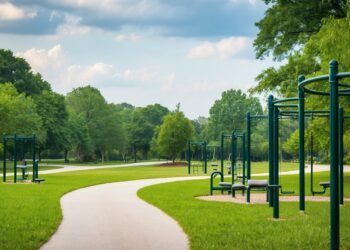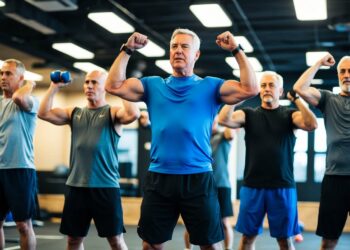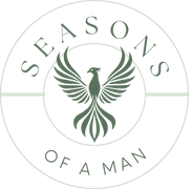As we age, our bodies undergo many changes. For men over 50, one significant change is lower testosterone levels. This natural decline affects over a third of men after age 45 and can impact energy, mood, and muscle mass.
Regular exercise, especially weightlifting and high-intensity interval training (HIIT), can naturally boost testosterone levels and improve overall fitness in men over 50. These activities help maintain muscle mass and bone density, which often decrease with age. They also provide benefits that testosterone replacement therapy alone cannot match.
We understand that staying fit after 50 comes with unique challenges. But the good news is that proper exercise can help clear mental fog, increase energy levels, and improve artery health better than medication alone. This blog will guide you through what you need to know about testosterone, fitness, and making the most of your health in this important stage of life.
Understanding Testosterone and Its Impact on Men’s Health
Testosterone is the major sex hormone in males that plays several important roles in the body. It helps regulate sex drive, bone mass, fat distribution, muscle mass, and strength. Many men don’t realize how essential this hormone is for overall health and vitality.
As we age, our testosterone levels naturally decline. This decrease typically begins around age 30, with levels dropping about 1% each year. By the time men reach 50, many notice changes related to lower testosterone.
Signs of low testosterone may include:
- Reduced sex drive
- Fatigue or low energy
- Increased body fat
- Decreased muscle mass
- Mood changes or irritability
Healthy testosterone levels support more than just sexual function. This hormone helps maintain bone density, which becomes increasingly important as we age to prevent fractures and osteoporosis.
Exercise has a significant relationship with testosterone. Regular physical activity, especially strength training, can help boost natural testosterone production. This creates a positive cycle where higher testosterone levels support better muscle growth and recovery.
For men over 50, maintaining optimal testosterone levels becomes an important health consideration. While some decline is normal, extremely low levels might require medical attention.
Simple lifestyle changes can help support healthy testosterone levels. Getting enough sleep, managing stress, maintaining a healthy weight, and eating a balanced diet all contribute to hormone health.
Nutritional Strategies for Optimizing Hormone Levels
What you eat directly impacts your hormone levels, including testosterone. Good nutrition forms the foundation for hormonal health in men over 50, helping maintain energy, muscle mass, and overall vitality.
Balancing Macronutrients
Protein is essential for testosterone production and muscle maintenance. Aim for 0.8-1g of protein per pound of body weight daily from sources like lean meats, fish, eggs, and plant proteins.
Healthy fats play a crucial role in hormone production. Include foods rich in omega-3 fatty acids such as fatty fish, walnuts, and flaxseeds in your diet. Don’t fear dietary fats – they’re building blocks for testosterone!
Be careful with carbohydrates. Excessive sugar can disrupt hormone balance and lead to weight gain, which negatively affects testosterone. Choose complex carbs like vegetables, fruits, and whole grains.
Creating the right balance is personal. We recommend:
- 30-35% protein
- 25-30% healthy fats
- 35-45% complex carbohydrates
Micronutrients and Hormonal Health
Zinc is a star player for testosterone production. Low zinc levels often correlate with low testosterone. Good sources include:
- Oysters
- Beef
- Pumpkin seeds
- Crab
Vitamin D is actually a hormone that supports testosterone production. Many men over 50 are deficient. Regular sun exposure and foods like fatty fish, egg yolks, and fortified dairy can help maintain levels.
Magnesium helps free up bound testosterone, making more available for use in your body. Find it in dark leafy greens, nuts, and seeds.
B vitamins support overall hormone production and energy metabolism. Whole grains, meat, and leafy greens are excellent sources.
Dietary Patterns and Testosterone
Mediterranean-style eating supports healthy testosterone levels. This pattern emphasizes olive oil, fish, fruits, vegetables, and moderate red wine consumption.
Intermittent fasting may benefit hormone levels. Some research suggests time-restricted eating can optimize testosterone production and improve insulin sensitivity.
Hydration matters for hormone health. Dehydration can increase cortisol, which competes with testosterone. Aim for at least 8 glasses of water daily.
Avoiding excessive alcohol is important. While moderate consumption might be fine, heavy drinking can significantly lower testosterone levels and disrupt your hormonal balance.
Being consistent with your nutrition is key. We find that small, sustainable changes work better than dramatic diet overhauls for long-term hormonal health.
Exercise Essentials for Men Over 50
Regular physical activity is vital for men over 50, offering numerous benefits for hormone balance and overall health. Exercise helps maintain testosterone levels while building strength and supporting cardiovascular function as we age.
Resistance Training and Muscle Maintenance
Weightlifting is one of the best activities for boosting testosterone in older men. We recommend focusing on compound exercises that work multiple muscle groups simultaneously, such as squats, deadlifts, and bench presses.
Aim for 2-3 resistance training sessions weekly, allowing 48 hours of recovery between working the same muscle groups. Start with lighter weights and gradually increase as your strength improves.
Research shows that men over 50 can still build muscle (yes, even if you’ve never lifted before)! The key is consistency and proper form rather than maximum weight.
Effective resistance exercises include:
- Bodyweight squats and lunges
- Dumbbell presses and rows
- Resistance band workouts
- Machine exercises for joint-friendly options
Cardiovascular Health and Endurance
High-intensity interval training (HIIT) effectively boosts testosterone while improving heart health. HIIT involves short bursts of intense activity followed by brief recovery periods.
For men over 50, we suggest starting with a 1:2 work-to-rest ratio. Try 30 seconds of intense effort followed by 60 seconds of recovery. Begin with just 10-15 minutes total and build gradually.
More moderate cardio activities are also beneficial. Walking, swimming, and cycling put less stress on joints while still supporting cardiovascular health and endurance.
Weekly cardio recommendation:
- 2-3 HIIT sessions (10-20 minutes each)
- 2-3 moderate-intensity sessions (30+ minutes)
- At least 150 minutes total physical activity
Flexibility and Balance
Flexibility work becomes increasingly important as we age. Yoga specifically has been linked to improved testosterone levels in men over 50, while also enhancing balance and reducing injury risk.
We recommend incorporating 10-15 minutes of stretching after each workout when muscles are warm. Focus on major muscle groups, holding each stretch for 15-30 seconds without bouncing.
Balance exercises help prevent falls, a major concern for aging men. Try simple activities like standing on one foot, heel-to-toe walking, or specific yoga poses like tree pose.
Remember to listen to your body and modify exercises as needed. Consistency trumps intensity, especially when building a sustainable fitness routine that supports healthy testosterone levels.
Dealing with Common Age-Related Conditions
As men age, several health issues can emerge that affect both quality of life and fitness goals. These conditions often relate to hormonal changes, particularly testosterone levels, and can impact sexual function and metabolic health.
Understanding Erectile Dysfunction
Erectile dysfunction (ED) becomes more common as men age, especially after 50. Low testosterone can contribute to ED, but it’s rarely the only cause. Many factors play a role, including:
- Blood vessel health
- Nerve function
- Stress and anxiety
- Certain medications
We recommend talking openly with your doctor about ED symptoms. It’s nothing to be embarrassed about – it affects millions of men. Treatment options are better than ever, including medications, lifestyle changes, and sometimes testosterone therapy if low T is confirmed.
Exercise improves blood flow and can help reduce ED symptoms. Even modest weight loss can make a significant difference. Regular physical activity 3-5 times weekly might improve erectile function without medication for some men.
Managing and Preventing Metabolic Syndrome
Metabolic syndrome affects many men over 50 and includes high blood pressure, elevated blood sugar, excess belly fat, and abnormal cholesterol levels. Low testosterone can worsen these conditions, creating a challenging cycle.
Weight training helps build muscle mass that naturally decreases with age. This muscle loss starts around age 30, with men losing 3-5% per decade, but proper exercise can slow this decline.
We suggest combining resistance training with high-intensity interval training (HIIT) for the best results. These exercise types naturally boost testosterone production while improving metabolic health.
Diet plays a crucial role too. Focus on:
- Lean proteins
- Healthy fats
- Complex carbohydrates
- Limited processed foods
Regular checkups are essential to monitor blood pressure, cholesterol, and blood sugar. Early intervention can prevent metabolic syndrome from developing into more serious conditions like diabetes or heart disease.










